Ship automatic track keeping at low speed
There are lots of ship’s situations when operating from port to port such as with full speed
sailing, reducing speed inside traffic scheme, stopping at a certain area and berthing operation with
designed heading angle. However, the previous studies on ship automatic track -keeping controllers
have not been designed properly as they considered that the ship speed is stable and in constant value.
It seems improperly situation in practical maneuverings, especially when the ship entering to ports.
In this paper, the authors focus on studying on the activities of the ship inside traffic scheme until ship
is stopped at certain area before berthing. We considered ship operation at low speed and reducing speed
situation under disturbance effect. However, in low speed and disturbance’s influence, ship’s Trackkeeping is not easy. Extra auxiliary devices such as tug-boats, ship’s bow and side thrusters, etc. are also
needed. Without these assistances, other methods should be needed in order to help the ship that called
“Boosting effect”. “Boosting effect” study will be introduced in this paper and numerical simulations
for this effect were carried out to perform the ship auto track-keeping inside traffic scheme at low speed
under disturbance influence. The results of simulations showed good performance and this designed
control can be adapted in near future
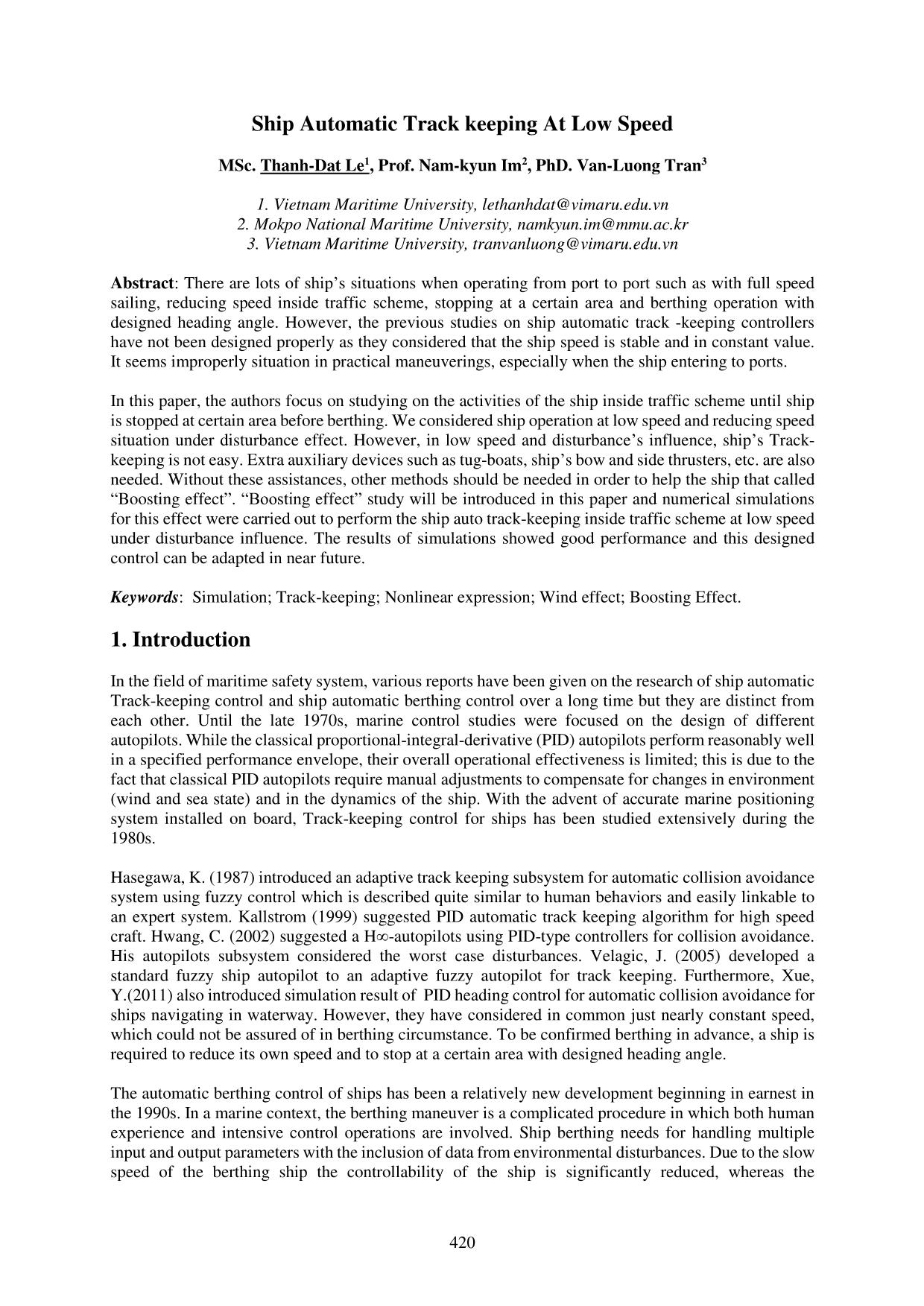
Trang 1

Trang 2
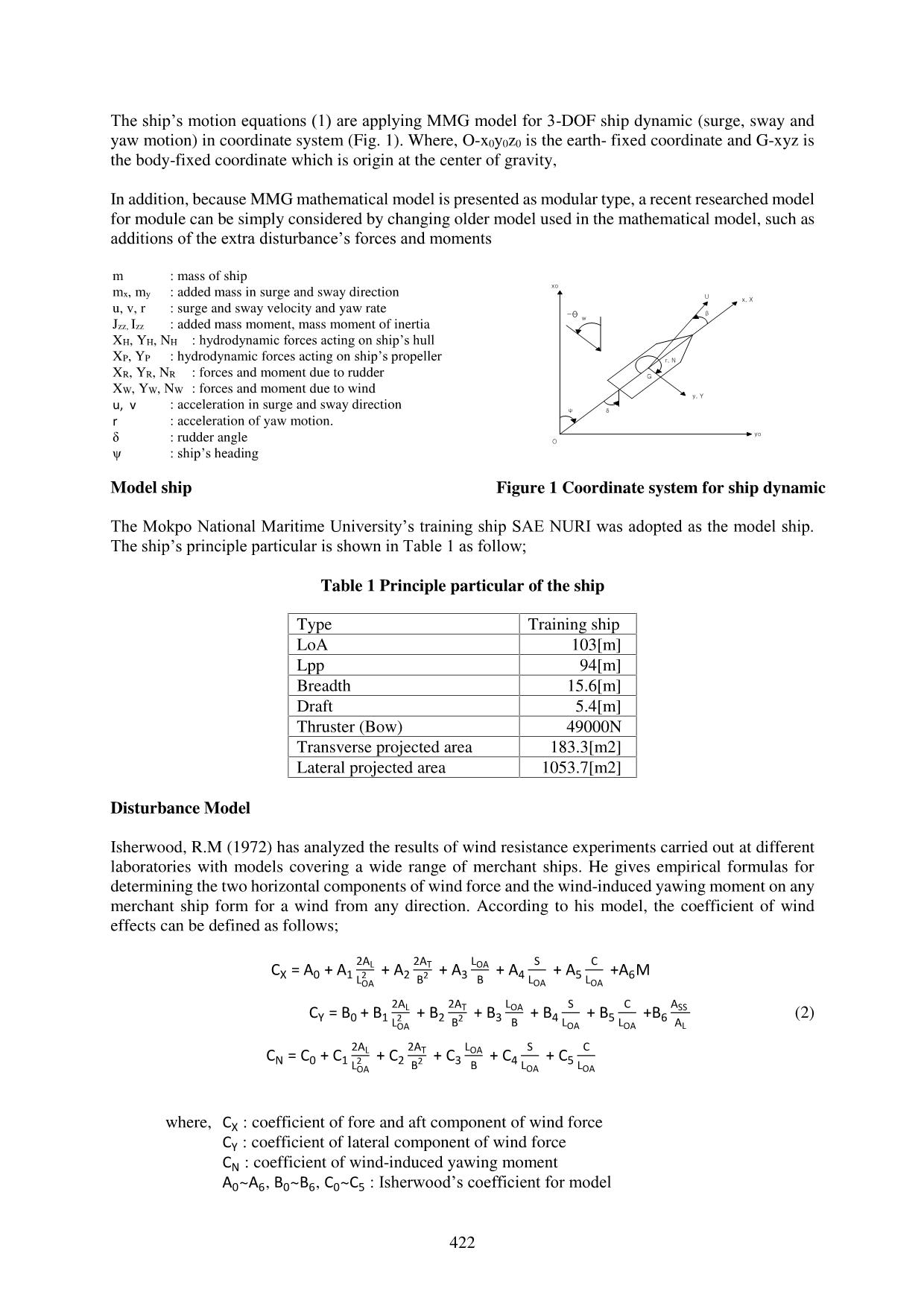
Trang 3
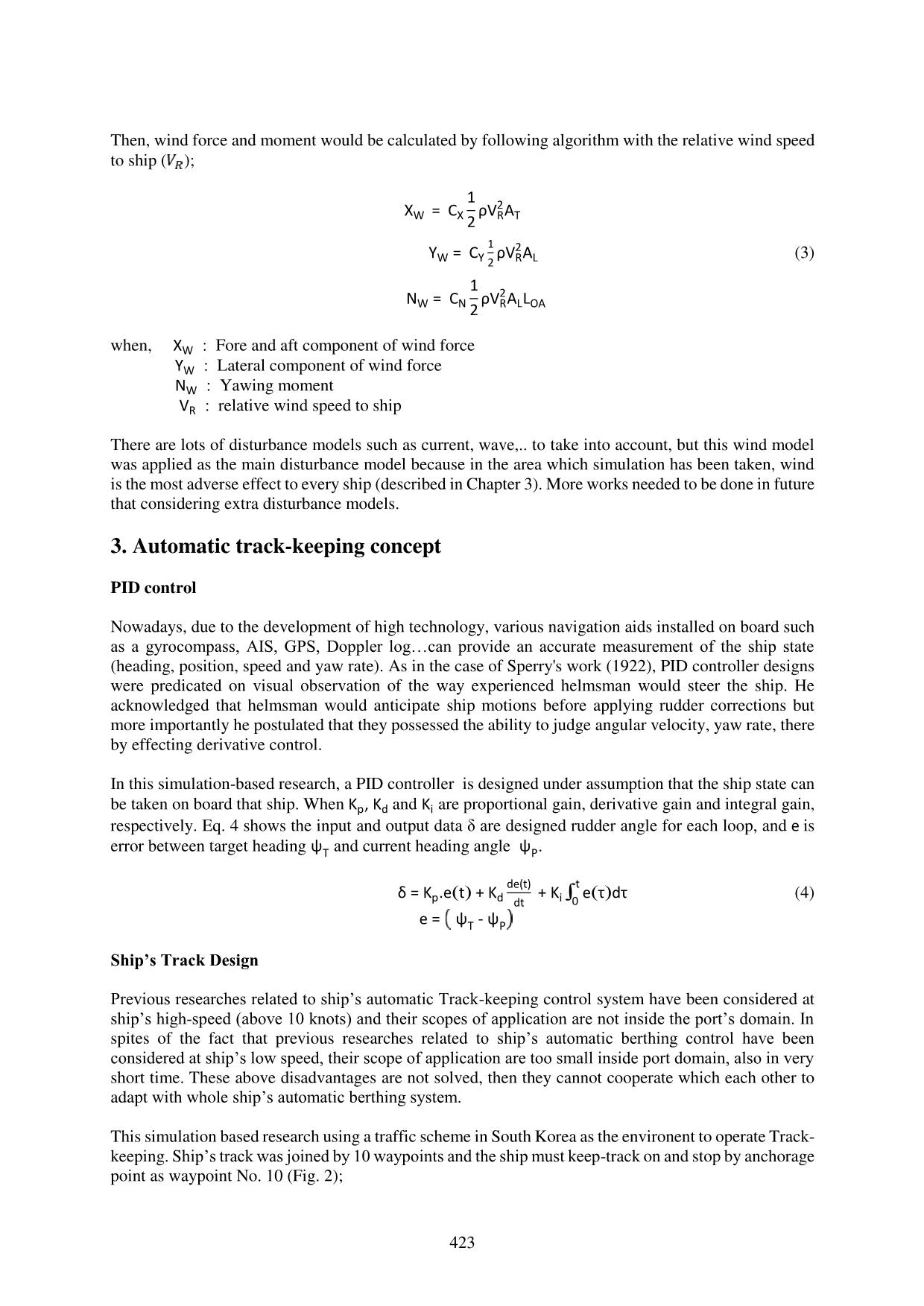
Trang 4

Trang 5
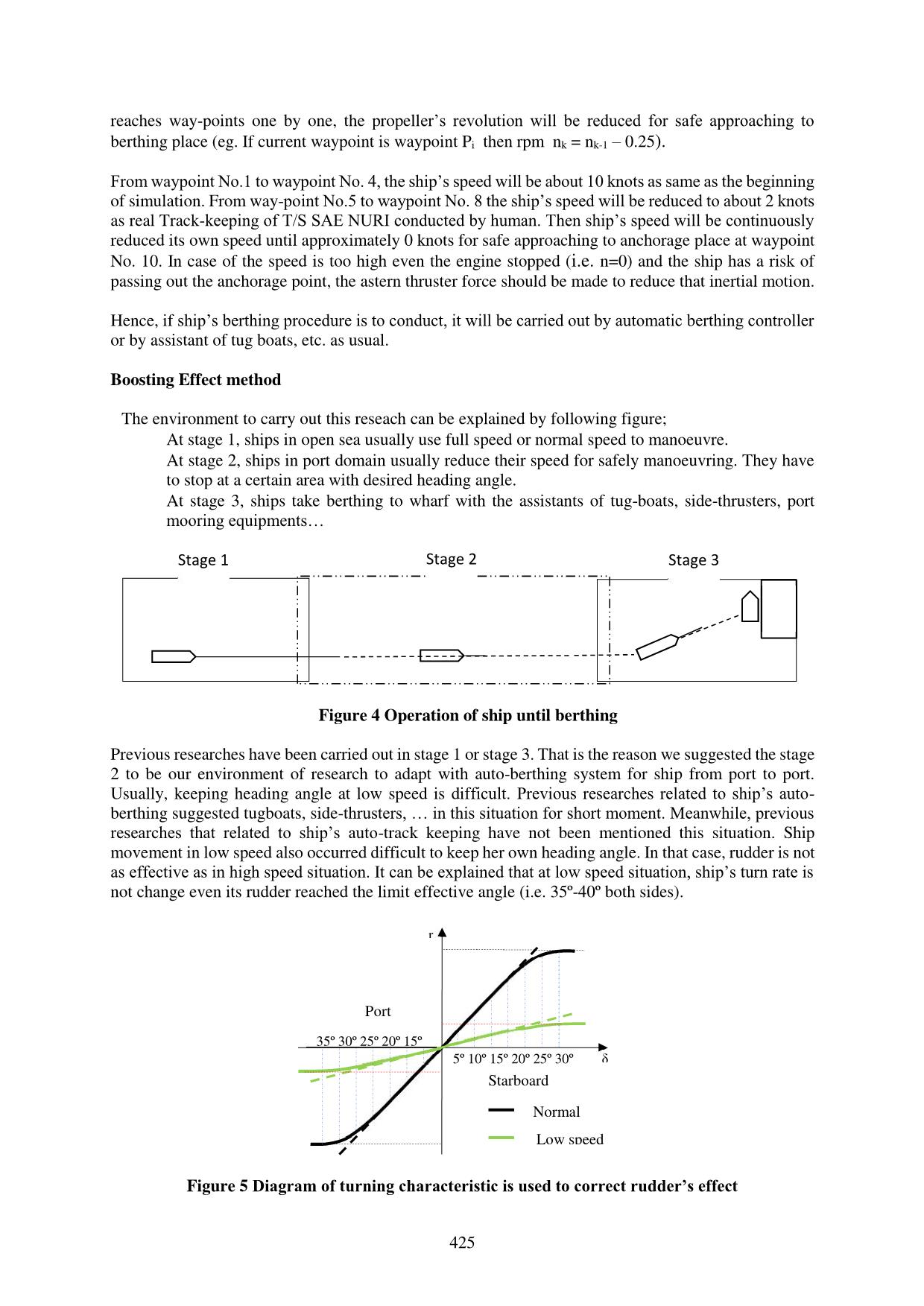
Trang 6
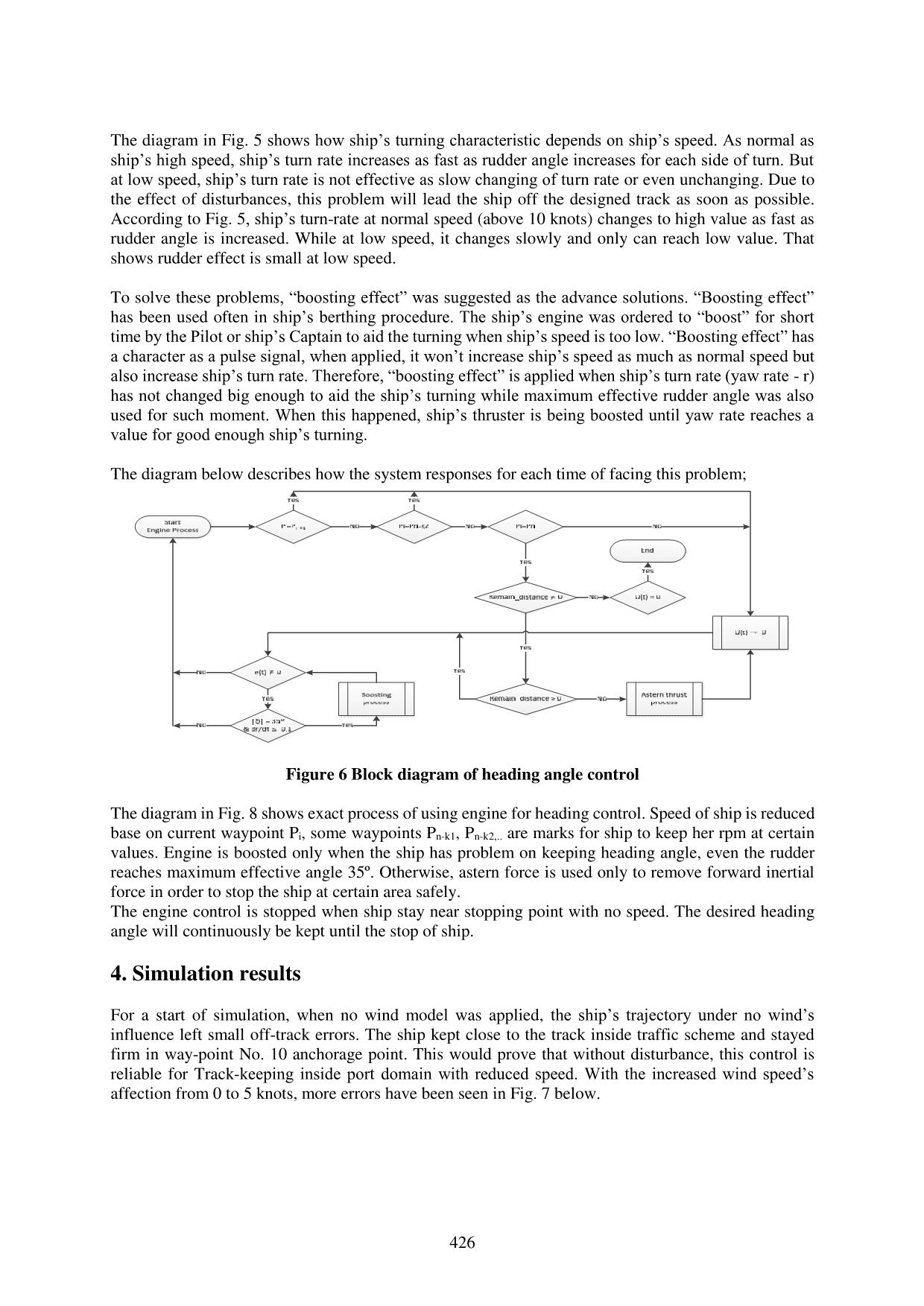
Trang 7
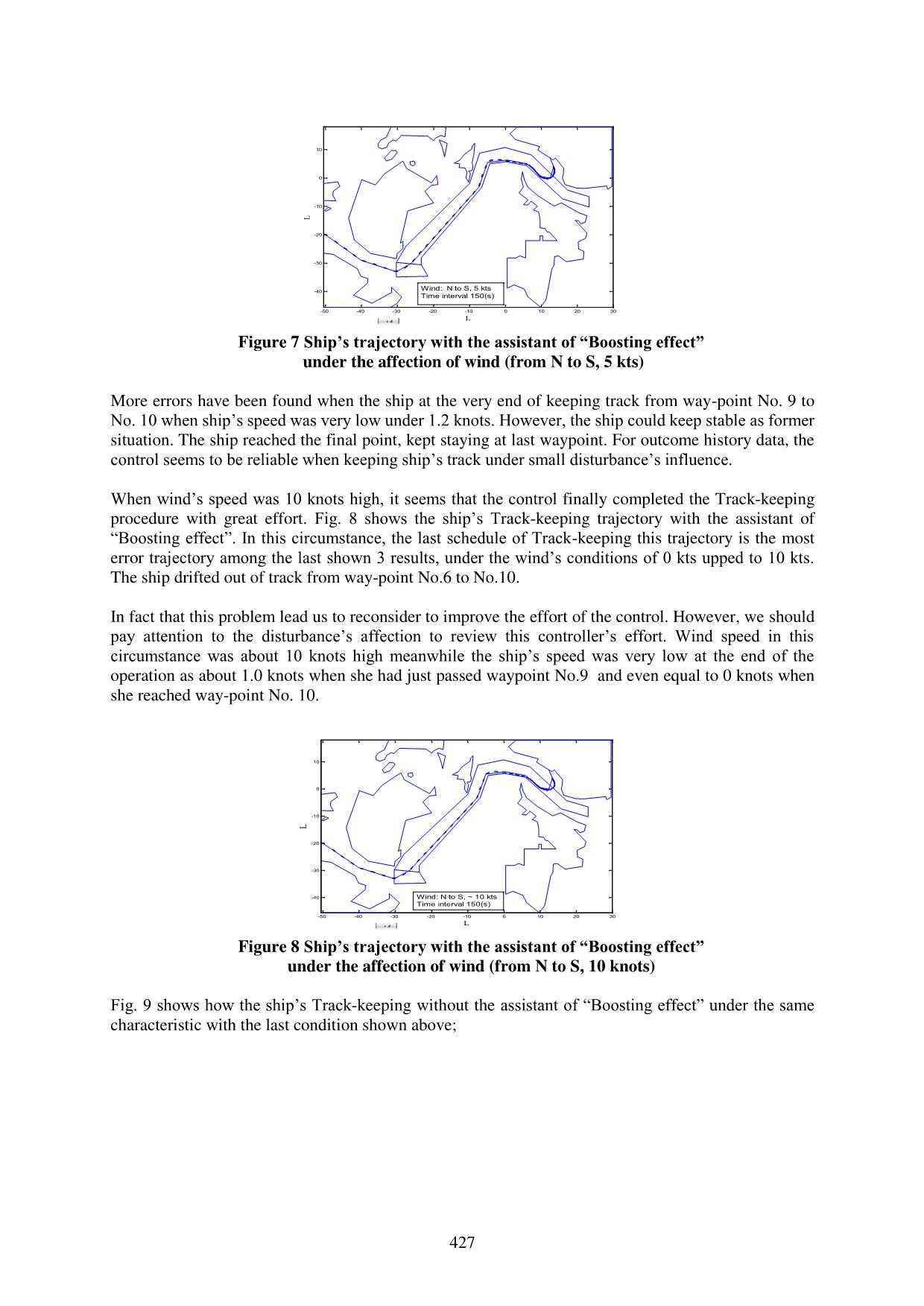
Trang 8
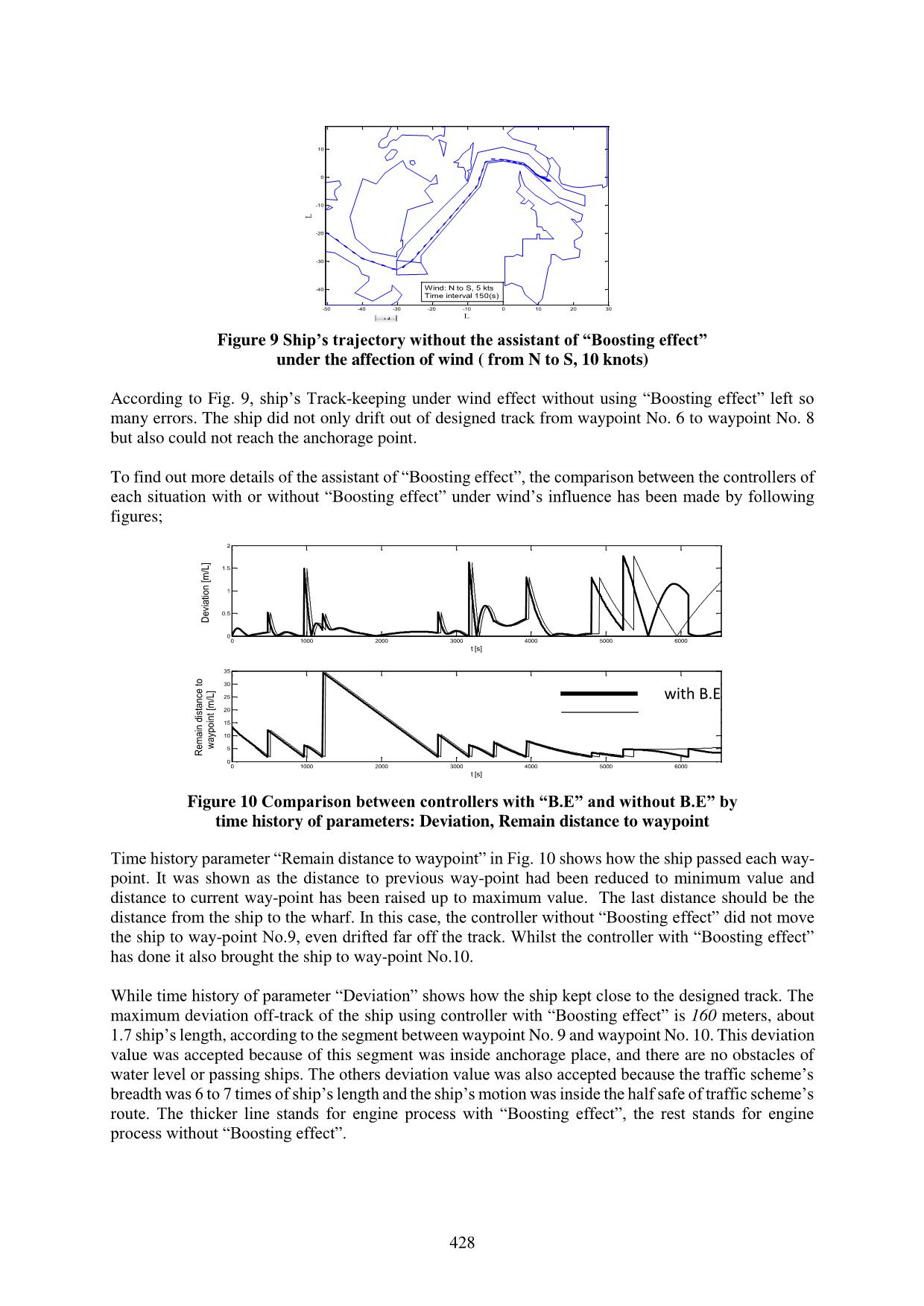
Trang 9
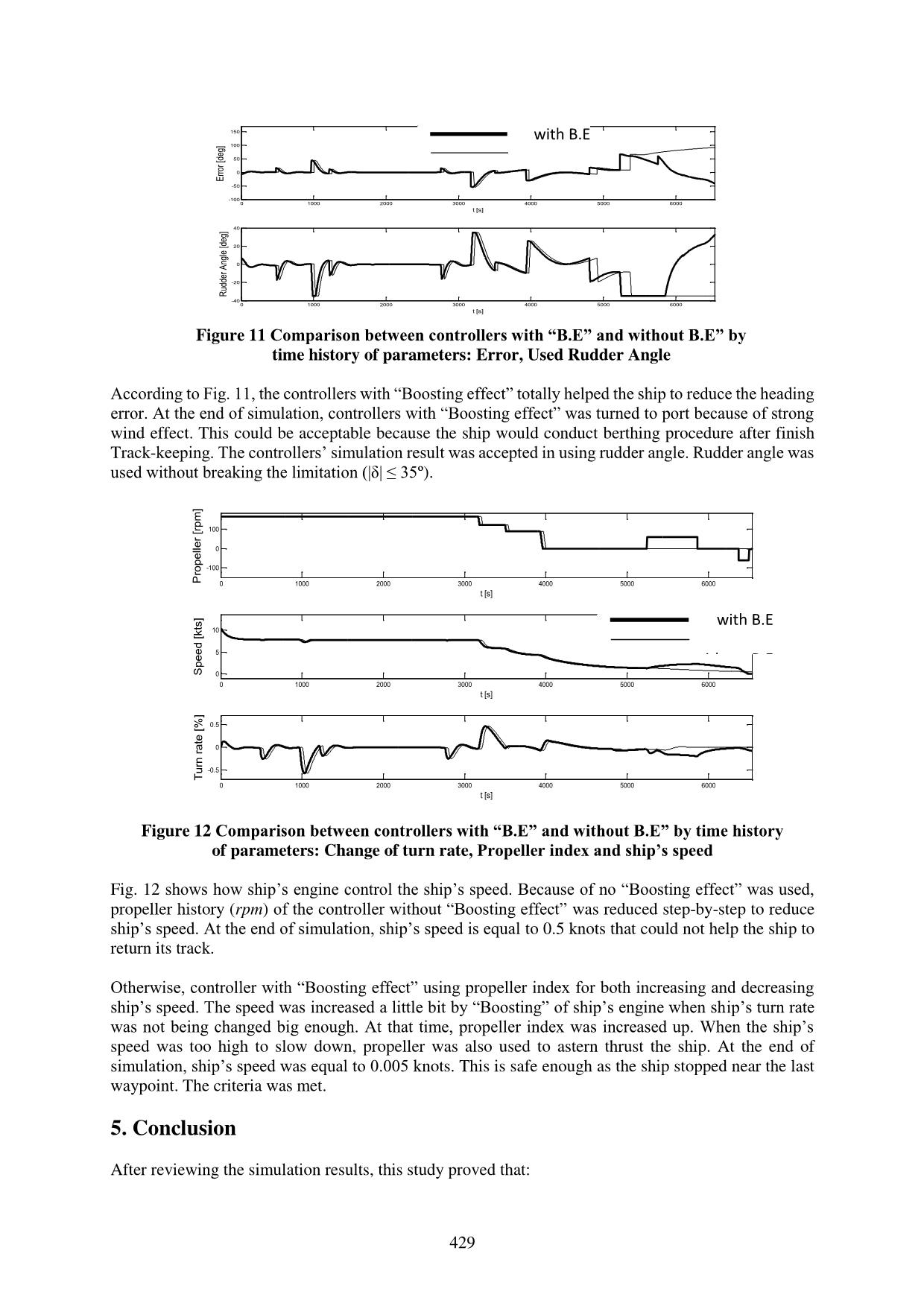
Trang 10
Tải về để xem bản đầy đủ
Tóm tắt nội dung tài liệu: Ship automatic track keeping at low speed
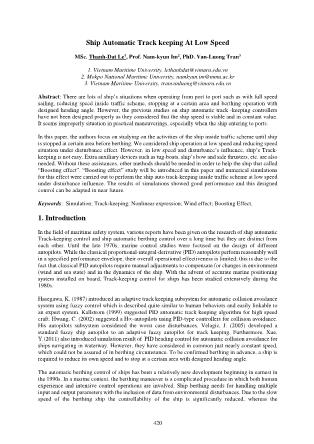
420 Ship Automatic Track keeping At Low Speed MSc. Thanh-Dat Le1, Prof. Nam-kyun Im2, PhD. Van-Luong Tran3 1. Vietnam Maritime University, lethanhdat@vimaru.edu.vn 2. Mokpo National Maritime University, namkyun.im@mmu.ac.kr 3. Vietnam Maritime University, tranvanluong@vimaru.edu.vn Abstract: There are lots of ship’s situations when operating from port to port such as with full speed sailing, reducing speed inside traffic scheme, stopping at a certain area and berthing operation with designed heading angle. However, the previous studies on ship automatic track -keeping controllers have not been designed properly as they considered that the ship speed is stable and in constant value. It seems improperly situation in practical maneuverings, especially when the ship entering to ports. In this paper, the authors focus on studying on the activities of the ship inside traffic scheme until ship is stopped at certain area before berthing. We considered ship operation at low speed and reducing speed situation under disturbance effect. However, in low speed and disturbance’s influence, ship’s Track- keeping is not easy. Extra auxiliary devices such as tug-boats, ship’s bow and side thrusters, etc. are also needed. Without these assistances, other methods should be needed in order to help the ship that called “Boosting effect”. “Boosting effect” study will be introduced in this paper and numerical simulations for this effect were carried out to perform the ship auto track-keeping inside traffic scheme at low speed under disturbance influence. The results of simulations showed good performance and this designed control can be adapted in near future. Keywords: Simulation; Track-keeping; Nonlinear expression; Wind effect; Boosting Effect. 1. Introduction In the field of maritime safety system, various reports have been given on the research of ship automatic Track-keeping control and ship automatic berthing control over a long time but they are distinct from each other. Until the late 1970s, marine control studies were focused on the design of different autopilots. While the classical proportional-integral-derivative (PID) autopilots perform reasonably well in a specified performance envelope, their overall operational effectiveness is limited; this is due to the fact that classical PID autopilots require manual adjustments to compensate for changes in environment (wind and sea state) and in the dynamics of the ship. With the advent of accurate marine positioning system installed on board, Track-keeping control for ships has been studied extensively during the 1980s. Hasegawa, K. (1987) introduced an adaptive track keeping subsystem for automatic collision avoidance system using fuzzy control which is described quite similar to human behaviors and easily linkable to an expert system. Kallstrom (1999) suggested PID automatic track keeping algorithm for high speed craft. Hwang, C. (2002) suggested a H∞-autopilots using PID-type controllers for collision avoidance. His autopilots subsystem considered the worst case disturbances. Velagic, J. (2005) developed a standard fuzzy ship autopilot to an adaptive fuzzy autopilot for track keeping. Furthermore, Xue, Y.(2011) also introduced simulation result of PID heading control for automatic collision avoidance for ships navigating in waterway. However, they have considered in common just nearly constant speed, which could not be assured of in berthing circumstance. To be confirmed berthing in advance, a ship is required to reduce its own speed and to stop at a certain area with designed heading angle. The automatic berthing control of ships has been a relatively new development beginning in earnest in the 1990s. In a marine context, the berthing maneuver is a complicated procedure in which both human experience and intensive control operations are involved. Ship berthing needs for handling multiple input and output parameters with the inclusion of data from environmental disturbances. Due to the slow speed of the berthing ship the controllability of the ship is significantly reduced, whereas the 421 disturbances from wind and current can become relatively large; intensive rudder/propeller adjustments and large lateral movement of the ship can intensify the non-linear aspects of the ship dynamics, making the behavior of the ship rather unpredictable; ship motion at low advance speed is difficult to represent using differential equations, there by negating most control methods which are dependent upon the mathematical model of the dynamics of the ship; the shallow water and bank effects will add further adverse influence upon the ship handling. Hasegawa, K. and Im, N (2002) introduced comparison method in which wind forces and moment were compared with rudder and thrusters forces and moment respectively when ship maneuvers in port. More recently, Tran, V (2012) used nonlinear mathematical expression and equilibrium equation to calculated critical wind velocity in automatic berthing. These researches was successful as the effects of the wind to ship maneuvering were clearly verified. Although considering low speed situation and disturbances, those previous researches on automatic berthing control have been carried out in very short circumstances with few steps to finish the operation. And even they suggested auxiliary devices, it still did not make a perfectly benefit for whole auto-berthing system for ship from port to port. Usually, the ship that manned carries out three stages to be berthed at a quay; Stage 1, the ship departs from previous port, takes manoeuvring through open sea, then approaches the entrance of port of arrival. She often operates at normal speed or full speed. Previous researches on auto-Track-keeping are in this stage; Stage 2, she navigates inside traffic scheme route leading to a certain area with reducing speed. She stops at that area with desired heading angle; Stage 3, ... No.5 to waypoint No. 8 the ship’s speed will be reduced to about 2 knots as real Track-keeping of T/S SAE NURI conducted by human. Then ship’s speed will be continuously reduced its own speed until approximately 0 knots for safe approaching to anchorage place at waypoint No. 10. In case of the speed is too high even the engine stopped (i.e. n=0) and the ship has a risk of passing out the anchorage point, the astern thruster force should be made to reduce that inertial motion. Hence, if ship’s berthing procedure is to conduct, it will be carried out by automatic berthing controller or by assistant of tug boats, etc. as usual. Boosting Effect method The environment to carry out this reseach can be explained by following figure; At stage 1, ships in open sea usually use full speed or normal speed to manoeuvre. At stage 2, ships in port domain usually reduce their speed for safely manoeuvring. They have to stop at a certain area with desired heading angle. At stage 3, ships take berthing to wharf with the assistants of tug-boats, side-thrusters, port mooring equipments Figure 4 Operation of ship until berthing Previous researches have been carried out in stage 1 or stage 3. That is the reason we suggested the stage 2 to be our environment of research to adapt with auto-berthing system for ship from port to port. Usually, keeping heading angle at low speed is difficult. Previous researches related to ship’s auto- berthing suggested tugboats, side-thrusters, in this situation for short moment. Meanwhile, previous researches that related to ship’s auto-track keeping have not been mentioned this situation. Ship movement in low speed also occurred difficult to keep her own heading angle. In that case, rudder is not as effective as in high speed situation. It can be explained that at low speed situation, ship’s turn rate is not change even its rudder reached the limit effective angle (i.e. 35º-40º both sides). Figure 5 Diagram of turning characteristic is used to correct rudder’s effect Stage 1 Stage 3Stage 2 5º 10º 15º 20º 25º 30º 35º 35º 30º 25º 20º 15º 10º 5º Port Starboard r δ Normal speedLow speed 426 The diagram in Fig. 5 shows how ship’s turning characteristic depends on ship’s speed. As normal as ship’s high speed, ship’s turn rate increases as fast as rudder angle increases for each side of turn. But at low speed, ship’s turn rate is not effective as slow changing of turn rate or even unchanging. Due to the effect of disturbances, this problem will lead the ship off the designed track as soon as possible. According to Fig. 5, ship’s turn-rate at normal speed (above 10 knots) changes to high value as fast as rudder angle is increased. While at low speed, it changes slowly and only can reach low value. That shows rudder effect is small at low speed. To solve these problems, “boosting effect” was suggested as the advance solutions. “Boosting effect” has been used often in ship’s berthing procedure. The ship’s engine was ordered to “boost” for short time by the Pilot or ship’s Captain to aid the turning when ship’s speed is too low. “Boosting effect” has a character as a pulse signal, when applied, it won’t increase ship’s speed as much as normal speed but also increase ship’s turn rate. Therefore, “boosting effect” is applied when ship’s turn rate (yaw rate - r) has not changed big enough to aid the ship’s turning while maximum effective rudder angle was also used for such moment. When this happened, ship’s thruster is being boosted until yaw rate reaches a value for good enough ship’s turning. The diagram below describes how the system responses for each time of facing this problem; Figure 6 Block diagram of heading angle control The diagram in Fig. 8 shows exact process of using engine for heading control. Speed of ship is reduced base on current waypoint Pi, some waypoints Pn-k1, Pn-k2,.. are marks for ship to keep her rpm at certain values. Engine is boosted only when the ship has problem on keeping heading angle, even the rudder reaches maximum effective angle 35º. Otherwise, astern force is used only to remove forward inertial force in order to stop the ship at certain area safely. The engine control is stopped when ship stay near stopping point with no speed. The desired heading angle will continuously be kept until the stop of ship. 4. Simulation results For a start of simulation, when no wind model was applied, the ship’s trajectory under no wind’s influence left small off-track errors. The ship kept close to the track inside traffic scheme and stayed firm in way-point No. 10 anchorage point. This would prove that without disturbance, this control is reliable for Track-keeping inside port domain with reduced speed. With the increased wind speed’s affection from 0 to 5 knots, more errors have been seen in Fig. 7 below. 427 Figure 7 Ship’s trajectory with the assistant of “Boosting effect” under the affection of wind (from N to S, 5 kts) More errors have been found when the ship at the very end of keeping track from way-point No. 9 to No. 10 when ship’s speed was very low under 1.2 knots. However, the ship could keep stable as former situation. The ship reached the final point, kept staying at last waypoint. For outcome history data, the control seems to be reliable when keeping ship’s track under small disturbance’s influence. When wind’s speed was 10 knots high, it seems that the control finally completed the Track-keeping procedure with great effort. Fig. 8 shows the ship’s Track-keeping trajectory with the assistant of “Boosting effect”. In this circumstance, the last schedule of Track-keeping this trajectory is the most error trajectory among the last shown 3 results, under the wind’s conditions of 0 kts upped to 10 kts. The ship drifted out of track from way-point No.6 to No.10. In fact that this problem lead us to reconsider to improve the effort of the control. However, we should pay attention to the disturbance’s affection to review this controller’s effort. Wind speed in this circumstance was about 10 knots high meanwhile the ship’s speed was very low at the end of the operation as about 1.0 knots when she had just passed waypoint No.9 and even equal to 0 knots when she reached way-point No. 10. Figure 8 Ship’s trajectory with the assistant of “Boosting effect” under the affection of wind (from N to S, 10 knots) Fig. 9 shows how the ship’s Track-keeping without the assistant of “Boosting effect” under the same characteristic with the last condition shown above; -50 -40 -30 -20 -10 0 10 20 30 -40 -30 -20 -10 0 10 L L Wind: N to S, 5 kts Time interval 150(s) -50 -40 -30 -20 -10 0 10 20 30 -40 -30 -20 -10 0 10 L L Wind: N to S, ~ 10 kts Time interval 150(s) 428 Figure 9 Ship’s trajectory without the assistant of “Boosting effect” under the affection of wind ( from N to S, 10 knots) According to Fig. 9, ship’s Track-keeping under wind effect without using “Boosting effect” left so many errors. The ship did not only drift out of designed track from waypoint No. 6 to waypoint No. 8 but also could not reach the anchorage point. To find out more details of the assistant of “Boosting effect”, the comparison between the controllers of each situation with or without “Boosting effect” under wind’s influence has been made by following figures; Figure 10 Comparison between controllers with “B.E” and without B.E” by time history of parameters: Deviation, Remain distance to waypoint Time history parameter “Remain distance to waypoint” in Fig. 10 shows how the ship passed each way- point. It was shown as the distance to previous way-point had been reduced to minimum value and distance to current way-point has been raised up to maximum value. The last distance should be the distance from the ship to the wharf. In this case, the controller without “Boosting effect” did not move the ship to way-point No.9, even drifted far off the track. Whilst the controller with “Boosting effect” has done it also brought the ship to way-point No.10. While time history of parameter “Deviation” shows how the ship kept close to the designed track. The maximum deviation off-track of the ship using controller with “Boosting effect” is 160 meters, about 1.7 ship’s length, according to the segment between waypoint No. 9 and waypoint No. 10. This deviation value was accepted because of this segment was inside anchorage place, and there are no obstacles of water level or passing ships. The others deviation value was also accepted because the traffic scheme’s breadth was 6 to 7 times of ship’s length and the ship’s motion was inside the half safe of traffic scheme’s route. The thicker line stands for engine process with “Boosting effect”, the rest stands for engine process without “Boosting effect”. -50 -40 -30 -20 -10 0 10 20 30 -40 -30 -20 -10 0 10 L L Wind: N to S, 5 kts Time interval 150(s) 0 1000 2000 3000 4000 5000 60000 0.5 1 1.5 2 t [s] De via tion [m /L] 0 1000 2000 3000 4000 5000 60000 5 10 15 20 25 30 35 t [s] Re ma in d ista nce to wa ypo int [m/ L] with B.E without B.E 429 Figure 11 Comparison between controllers with “B.E” and without B.E” by time history of parameters: Error, Used Rudder Angle According to Fig. 11, the controllers with “Boosting effect” totally helped the ship to reduce the heading error. At the end of simulation, controllers with “Boosting effect” was turned to port because of strong wind effect. This could be acceptable because the ship would conduct berthing procedure after finish Track-keeping. The controllers’ simulation result was accepted in using rudder angle. Rudder angle was used without breaking the limitation (|δ| ≤ 35º). Figure 12 Comparison between controllers with “B.E” and without B.E” by time history of parameters: Change of turn rate, Propeller index and ship’s speed Fig. 12 shows how ship’s engine control the ship’s speed. Because of no “Boosting effect” was used, propeller history (rpm) of the controller without “Boosting effect” was reduced step-by-step to reduce ship’s speed. At the end of simulation, ship’s speed is equal to 0.5 knots that could not help the ship to return its track. Otherwise, controller with “Boosting effect” using propeller index for both increasing and decreasing ship’s speed. The speed was increased a little bit by “Boosting” of ship’s engine when ship’s turn rate was not being changed big enough. At that time, propeller index was increased up. When the ship’s speed was too high to slow down, propeller was also used to astern thrust the ship. At the end of simulation, ship’s speed was equal to 0.005 knots. This is safe enough as the ship stopped near the last waypoint. The criteria was met. 5. Conclusion After reviewing the simulation results, this study proved that: 0 1000 2000 3000 4000 5000 6000-100 -50 0 50 100 150 t [s] Erro r [d eg] 0 1000 2000 3000 4000 5000 6000-40 -20 0 20 40 t [s] Rud der An gle [de g] 0 1000 2000 3000 4000 5000 6000 -100 0 100 t [s] Pr op ell er [rp m] 0 1000 2000 3000 4000 5000 6000 0 5 10 t [s] Sp ee d [ kts ] 0 1000 2000 3000 4000 5000 6000 -0.5 0 0.5 t [s] Tu rn rat e [ %] with B.E without B.E with B.E without B.E 430 The ship can use this controller for specific purpose of automatic Track-keeping at the specified moment as when finished ocean navigating and before berthing to a quay; in the specified place as Track-keeping insides traffic scheme that is leading to the wharf; and with difficulties are low speed, reducing speed and disturbance effect. Heading angle at low speed was controlled with the assistant of “Boosting effect” which is unfamiliar with other previous researches. “Boosting effect” was proved as a vital characteristic of this controller to aid the ship at low speed, under the strong wind and without any help of extra auxiliary devices. Acknowledgement This research was a part of the project titled “Development of Ship-handling and Passenger Evacuation Support System” funded by the Ministry of Oceans and Fisheries (South Korea - MOF). References [1] Fossen, T.I., Guidance and control of ocean vehicles, John Wiley & and Sons Ltd., ISBN 0-471- 94113-1, (1994) [2] Hamamoto, M., MMG report II, Bulletin of the society of Naval Architects of Japan, No. 577, pp. 322-329, (1997) [3] Hasegawa K., Automatic Collision avoidance system for ships using fuzzy control, Ship control system Symposium the 8th, vol.2, p. 34-58, (1987) [4] Hasegawa, K. and Im, N. K., A Study on Critical of Wind Velocity of a Ro-Ro Passenger Ship Equipped with Side Thrusters in a Port, Journal of the Kansai Society of Naval Architects, Japan, No. 238, p. 71-76, (2002) [5] Hwang, C., The Integrated Design of Fuzzy Collision-Avoidance and H∞-Auto pilots on Ships, Journal of Navigation, vol.55, p.117-136, (2002) [6] Isherwood, R.M., Wind Resistance of Merchant Ship, Trans. RINA, vol.115, p.327-338, (1972) [7] Kallstrom, C. G., Autopilot and Track-keeping Algorithm for High-speed Craft, Control Engineering Practice 8, p. 185-190, (1999) [8] Kinoshita, M. and Nakajima, Y., On the Effect of Wind on the Maneuverability of Vessels, Experiment Tank Committee of Japan, p. 11-24, (1951) [9] Martin, L.L., Ship Maneuvering and Control in Wind, Trans. SNAME, vol.88, p.257-281, (1980) [10] Sperry, E. A., Automatic steering, Trans. Society of Naval Architects and Marine Engineers, p. 61- 63, (1922) [11] Tran, V.L. and Im, N.K, A study on ship automatic berthing with assisstance of auxiliary devies, Journal of Korean Naval Architects of Ocean Engineering, p. 199-210, (2012) [12] Velagic, J., , Adaptive fuzzy ship autopilot for Track-keeping, Control Engineering Practice 11, pp. 433-443, (2003) [13] Xue, Y., Automatic Simulation of Ship Navigation, Ocean Engineering 38, pp. 2290-2299. (2011)
File đính kèm:
 ship_automatic_track_keeping_at_low_speed.pdf
ship_automatic_track_keeping_at_low_speed.pdf

